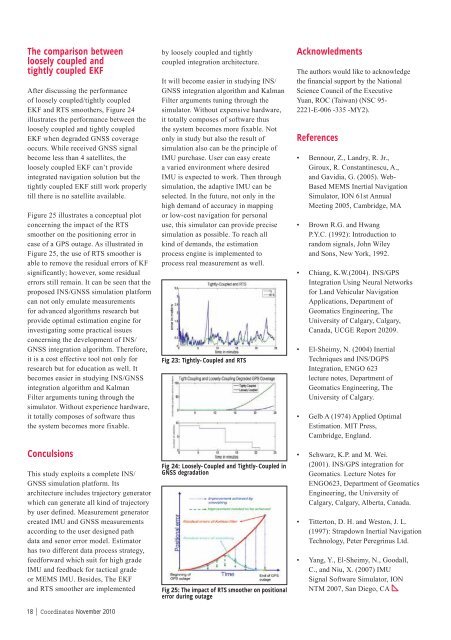Co-ordinates
Co-ordinates
Co-ordinates
Create successful ePaper yourself
Turn your PDF publications into a flip-book with our unique Google optimized e-Paper software.
The comparison between<br />
loosely coupled and<br />
tightly coupled EKF<br />
After discussing the performance<br />
of loosely coupled/tightly coupled<br />
EKF and RTS smoothers, Figure 24<br />
illustrates the performance between the<br />
loosely coupled and tightly coupled<br />
EKF when degraded GNSS coverage<br />
occurs. While received GNSS signal<br />
become less than 4 satellites, the<br />
loosely coupled EKF can’t provide<br />
integrated navigation solution but the<br />
tightly coupled EKF still work properly<br />
till there is no satellite available.<br />
Figure 25 illustrates a conceptual plot<br />
concerning the impact of the RTS<br />
smoother on the positioning error in<br />
case of a GPS outage. As illustrated in<br />
Figure 25, the use of RTS smoother is<br />
able to remove the residual errors of KF<br />
significantly; however, some residual<br />
errors still remain. It can be seen that the<br />
proposed INS/GNSS simulation platform<br />
can not only emulate measurements<br />
for advanced algorithms research but<br />
provide optimal estimation engine for<br />
investigating some practical issues<br />
concerning the development of INS/<br />
GNSS integration algorithm. Therefore,<br />
it is a cost effective tool not only for<br />
research but for education as well. It<br />
becomes easier in studying INS/GNSS<br />
integration algorithm and Kalman<br />
Filter arguments tuning through the<br />
simulator. Without experience hardware,<br />
it totally composes of software thus<br />
the system becomes more fixable.<br />
<strong>Co</strong>nculsions<br />
This study exploits a complete INS/<br />
GNSS simulation platform. Its<br />
architecture includes trajectory generator<br />
which can generate all kind of trajectory<br />
by user defined. Measurement generator<br />
created IMU and GNSS measurements<br />
according to the user designed path<br />
data and senor error model. Estimator<br />
has two different data process strategy,<br />
feedforward which suit for high grade<br />
IMU and feedback for tactical grade<br />
or MEMS IMU. Besides, The EKF<br />
and RTS smoother are implemented<br />
18 | <strong>Co</strong><strong>ordinates</strong> November 2010<br />
by loosely coupled and tightly<br />
coupled integration architecture.<br />
It will become easier in studying INS/<br />
GNSS integration algorithm and Kalman<br />
Filter arguments tuning through the<br />
simulator. Without expensive hardware,<br />
it totally composes of software thus<br />
the system becomes more fixable. Not<br />
only in study but also the result of<br />
simulation also can be the principle of<br />
IMU purchase. User can easy create<br />
a varied environment where desired<br />
IMU is expected to work. Then through<br />
simulation, the adaptive IMU can be<br />
selected. In the future, not only in the<br />
high demand of accuracy in mapping<br />
or low-cost navigation for personal<br />
use, this simulator can provide precise<br />
simulation as possible. To reach all<br />
kind of demands, the estimation<br />
process engine is implemented to<br />
process real measurement as well.<br />
Fig 23: Tightly-<strong>Co</strong>upled and RTS<br />
Fig 24: Loosely-<strong>Co</strong>upled and Tightly-<strong>Co</strong>upled in<br />
GNSS degradation<br />
Fig 25: The impact of RTS smoother on positional<br />
error during outage<br />
Acknowledments<br />
The authors would like to acknowledge<br />
the financial support by the National<br />
Science <strong>Co</strong>uncil of the Executive<br />
Yuan, ROC (Taiwan) (NSC 95-<br />
2221-E-006 -335 -MY2).<br />
References<br />
• Bennour, Z., Landry, R. Jr.,<br />
Giroux, R. <strong>Co</strong>nstantinescu, A.,<br />
and Gavidia, G. (2005). Web-<br />
Based MEMS Inertial Navigation<br />
Simulator, ION 61st Annual<br />
Meeting 2005, Cambridge, MA<br />
• Brown R.G. and Hwang<br />
P.Y.C. (1992): Introduction to<br />
random signals, John Wiley<br />
and Sons, New York, 1992.<br />
• Chiang, K.W.(2004). INS/GPS<br />
Integration Using Neural Networks<br />
for Land Vehicular Navigation<br />
Applications, Department of<br />
Geomatics Engineering, The<br />
University of Calgary, Calgary,<br />
Canada, UCGE Report 20209.<br />
• El-Sheimy, N. (2004) Inertial<br />
Techniques and INS/DGPS<br />
Integration, ENGO 623<br />
lecture notes, Department of<br />
Geomatics Engineering, The<br />
University of Calgary.<br />
• Gelb A (1974) Applied Optimal<br />
Estimation. MIT Press,<br />
Cambridge, England.<br />
• Schwarz, K.P. and M. Wei.<br />
(2001). INS/GPS integration for<br />
Geomatics. Lecture Notes for<br />
ENGO623, Department of Geomatics<br />
Engineering, the University of<br />
Calgary, Calgary, Alberta, Canada.<br />
• Titterton, D. H. and Weston, J. L.<br />
(1997): Strapdown Inertial Navigation<br />
Technology, Peter Peregrinus Ltd.<br />
• Yang, Y., El-Sheimy, N., Goodall,<br />
C., and Niu, X. (2007) IMU<br />
Signal Software Simulator, ION<br />
NTM 2007, San Diego, CA
















